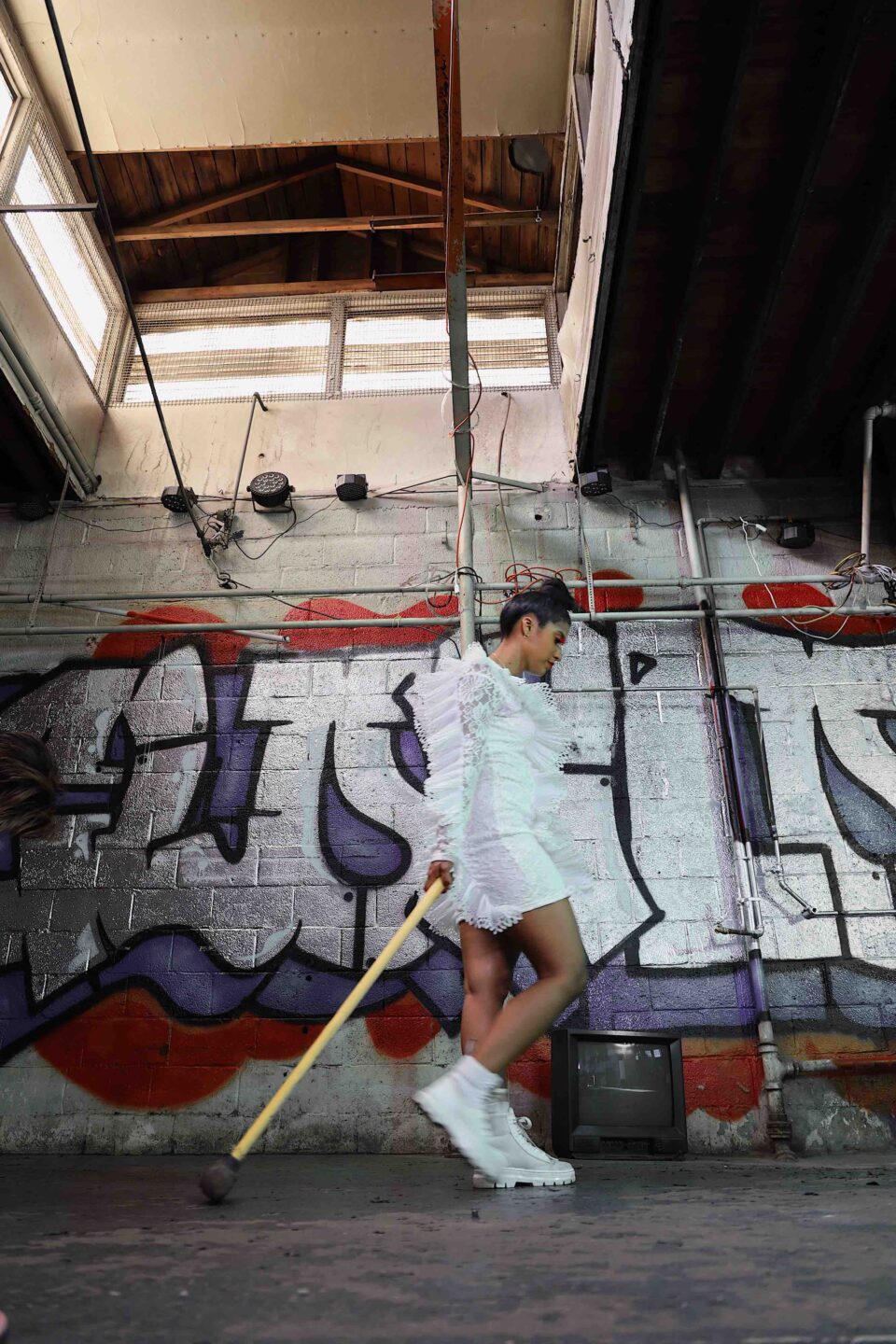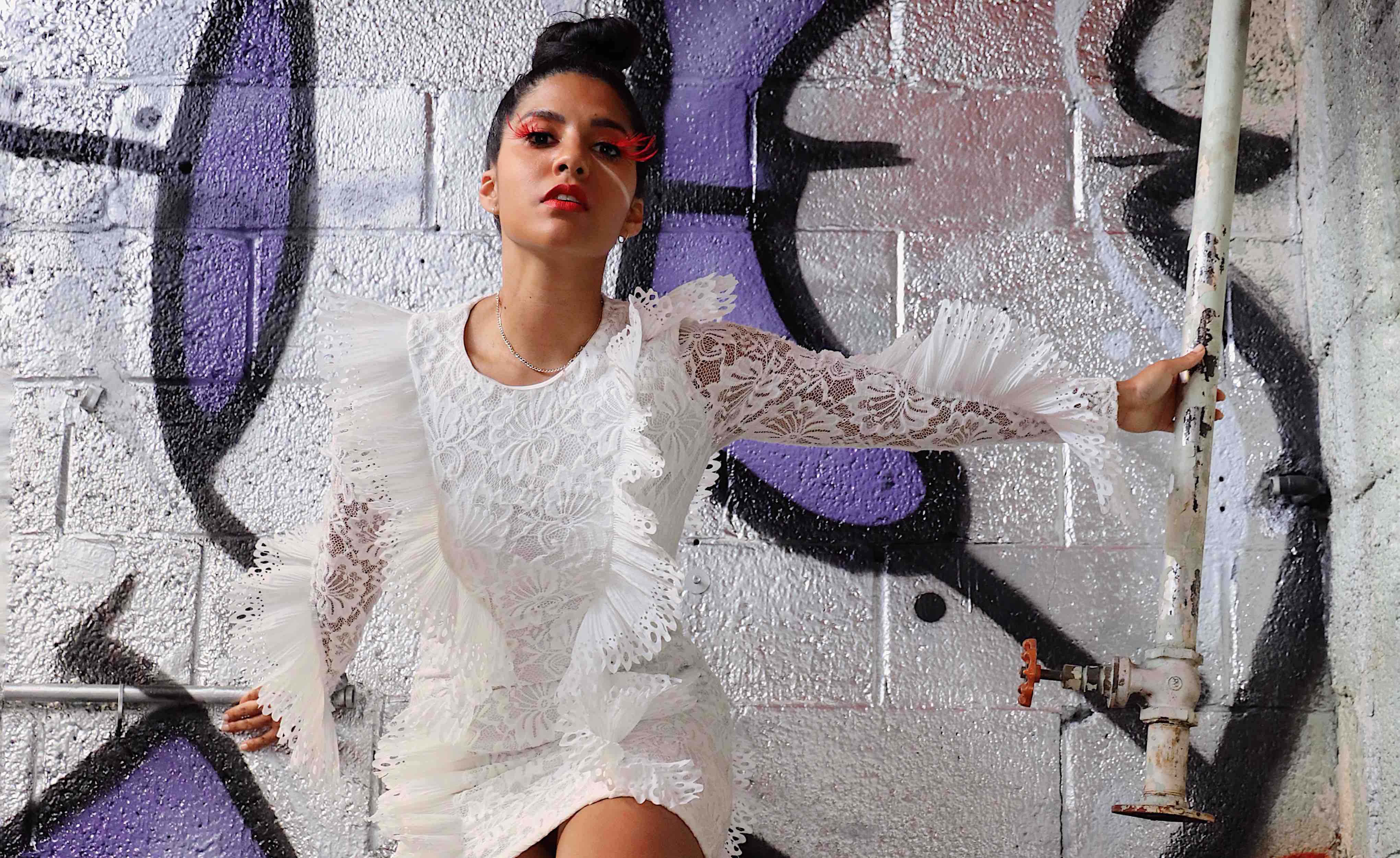This article appears in FLOOD 12: The Los Angeles Issue. You can purchase this special 232-page print edition celebrating the people, places, music and art of LA here.
BACKSTORY: A graduate of the Berklee College of Music whose multimedia output includes aural, verbal, performance, visual, and moving-image art
FROM: Born in Boston, moved to Trinidad as a baby, then to San Diego at age seven, now a resident of North Hollywood
YOU MIGHT KNOW HER FROM: Her hyper-creative videos for “Instant Gratification” and “Big Sunglasses” and her inventive video series of covers that range from Dolly Parton’s “Jolene” to Drake’s “Passionfruit”
NOW: Her first full-length album, The Id, and debut TED Talk both dropped in late 2021, with the final record in her Freudian trilogy, Superego, dropping soon
TRISHES walks into Hey Hey, the trendy and well-trafficked tea house in Echo Park, leading her beautiful Shiba Inu, Curry. She comes bearing gifts, which she presents with both hands, in a tidy square box.
The box’s lid features the same self-portrait as the cover of her debut album, The Id. Inside are five hand-drawn images and a hand-written missive, plus a thank-you note. The detailed images are of herself, and of objects and body parts represented in the songs of The Id. The box also includes a mini-canister of tiny colored pencils with a built-in sharpener, plus a square tin of gumballs, a reference to her candy-themed video for “Instant Gratification.” The tin has a QR code on it which, when scanned, goes to a smooth stream of The Id.
“When we don't feel like people are watching, or that we’re being held accountable, that anonymity can bring out our essential selves, and, in some cases, courage. It’s the same reason why people wore tribal paint when they would go to war, or masks.”
This thoughtfully curated gift collection is representative of TRISHES at this point in time. Born Trish Hosein, “TRISHES” is the name for her “project,” as she calls it, which is based in music but expressed through a number of mediums including illustration, film, spoken word, and performance art. The presentation of TRISHES began with her 2019 EP, Ego. It continues with The Id and will conclude with a future album, Superego. The Freudian psychoanalytic throughline of the bodies of work is obvious, but to TRISHES, they’re about what it means to be human.
“The id is associated with gratification, with fear and shame, and with internalized ideas, especially anonymity,” she explains in between gentle tugs on Curry’s leash and murmured assurances in response to his fidgets. “When we don't feel like people are watching, or that we’re being held accountable, that anonymity can bring out our essential selves, and, in some cases, courage. It's the same reason why people wore tribal paint when they would go to war, or masks.”

This concept is best expressed on “Big Sunglasses,” which ties in with another one of TRISHES’s obsessions, that of morality—how an individual determines what’s right and wrong, how that ties in with identity, community, and accountability, and whether the self that is detached from those elements is the true self. She delves further into this on “Animal.”
“In America, religion is tied to white supremacy, which is why it’s so punitive. A big part of TRISHES was my exploration of morality. The more connected we are and the more we serve each other, the happier we are. That’s the reality of humanity.”
“We develop morality because we need to function within communities,” says TRISHES. “As we evolved, morality became this tightrope between serving communities and serving yourself. I developed my morality through a mixture of my parents, the community, and religions I was exposed to. Trinidad is made up of Christian, Muslim, and Hindu people. Everyone was very loving toward each other, we celebrated all the holidays and I really liked religion in that framework. In America, religion is tied to white supremacy, which is why it's so punitive. A big part of TRISHES was my exploration of morality. I realized I was terribly unhappy being selfish. The more connected we are and the more we serve each other, the happier we are. That's the reality of humanity.”
But for a long time, TRISHES was angry. This was partially from her own deep internal wounds that she hadn’t worked through. But mainly it was an emotion projected onto her that, for a long time, she absorbed. “When a woman of color speaks the truth and it’s something uncomfortable that people don't want to hear, when we break that lens of exotification, it’s a lot easier to say we’re angry,” she says. “Anger is this idea that’s unfeminine as well. In a lot of ways, white supremacy would like femininity to be one in the same with submissiveness.”
There’s a heady mixture of emotion and militancy that comes with TRISHES’s live performances, which could come across as angry if they weren’t so engaging. Dressed in all-white with white streaks of paint on her face and an array of equipment on stage, TRISHES is a singer, a poet, a dancer, a studio musician, and a recording engineer all at the same time. She records herself reciting spoken-word passages and making improvised sounds while looping these recordings, triggering sounds, and singing along with interpretive and emotive movements.
“When a woman of color speaks the truth and it’s something uncomfortable that people don’t want to hear, when we break that lens of exotification, it’s a lot easier to say we’re angry.”
A live setting is the best representation of TRISHES’s multidisciplinary art, the individual components of which come together for a wonderfully cohesive and greater-than-its-parts whole. The other medium that especially lends itself to her work is video; with their high level of creativity and originality, TRISHES’s clips are like award-winning art school short films and a great gateway to connecting with her vision.
For the final piece in her Freudian trilogy, Superego, TRISHES’s focus will be on connectivity. As she gets ready to take Curry for a calming walk around the neighborhood she says, “Superego is going to be a little more positive. What are the connections between people? That’s what I miss the most about traveling: not seeing the differences, but the similarities.” FL







